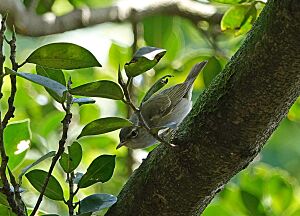Ijima's leaf warbler facts for kids
Quick facts for kids Ijima's leaf warbler |
|
|---|---|
 |
|
| Warbler in Taiwan (April 2021) | |
| Conservation status | |
| Scientific classification | |
| Genus: |
Phylloscopus
|
| Species: |
ijimae
|
| Synonyms | |
|
Acanthopneuste ijimae (protonym) |
|
The Ijima's leaf warbler (Phylloscopus ijimae) is a small bird that belongs to the Old World warbler family. It is also known as the Izu leaf warbler or Ijima's warbler. This bird is originally from Japan. In Japan, it is considered a Natural Monument because it is special and needs protection. You can also find records of this bird in Taiwan and the Philippines.
Contents
About Its Name
The Ijima's leaf warbler is a unique type of bird, meaning it's the only species in its group. It was first described in 1892 by a scientist named Leonhard Stejneger. He found three bird samples in 1887 on the Izu Islands in Japan.
Over the years, scientists changed the bird's scientific name a few times. At first, it was called Acanthopneuste ijimae. Later, some thought it was a type of western crowned warbler or eastern crowned warbler. But in 1953, scientists decided it was its own special species again, named Phylloscopus ijimae. This was because its songs, nesting habits, and DNA were different from other similar birds.
The bird's name, ijimae, honors Isao Ijima. He was a Japanese scientist who studied birds and helped us learn a lot about them.
What It Looks Like

Ijima's leaf warbler is a small passerine bird, which means it's a perching bird. It is about 11.5 centimeters (4.5 inches) long and weighs around 10 grams (0.35 ounces).
Its head and back of its neck are greenish-grey. Its upper body is a bright olive green, and its sides are greyish. Its belly is white. It has a long white stripe above its eye and a dark line through its eye. Its eyes are dark brown.
The bird's beak is quite long. The top part of the beak is dark brown, and the bottom part is yellowish. Its legs and feet are a pinkish-brown color.
This warbler looks a lot like the eastern crowned warbler. However, you can tell them apart because the Ijima's leaf warbler does not have a stripe down the middle of its head. Also, the feathers under its tail are a paler yellow. Their songs and calls are also different. Ijima's leaf warbler makes sounds like "swss, swss," "swee-swee," and "phi-phi-phi."
Where It Lives and Its Home
Ijima's leaf warbler spends its summers breeding in the Izu Islands of Japan. It also breeds on Nakanoshima in the Tokara Islands.
During spring and autumn, these birds have been seen in other parts of Honshu (like Shizuoka and Wakayama prefectures) and on islands like Tanegashima and Okinawa Island.
We don't know much about where they go for winter. Some might stay in the Izu Islands or the Ryukyu Islands. They have also been seen in Taiwan and the northern Philippines.
These warblers live in lowland forests. They like forests with trees that lose their leaves (deciduous) and mixed forests with both evergreen and other trees. They can also be found at the edge of forests, in areas with alder trees and bamboo, and in shrubland.
Life and Habits
The main food for Ijima's leaf warbler is insects. In fact, its Japanese name means "Ijima's insect-eater"! They also eat seeds.
They look for food alone or in small groups. Sometimes, they even join other birds, like long-tailed tits, to find food. They search for food on lower branches, high up in the trees, and even on the ground. They can also catch insects while flying.
Reproduction
The breeding season for Ijima's leaf warbler is from April to June or July. They build their nests about 0.5 to 2 meters (1.6 to 6.5 feet) off the ground. They build them in broad-leaved trees and in bamboo. This is different from the eastern crowned warbler, which usually nests on the ground.
A female warbler usually lays two to four eggs at a time. Three or four eggs are the most common number.
Protecting the Warbler
The number of Ijima's leaf warblers is going down. There are thought to be fewer than 10,000 of these birds left. They are threatened by losing their homes and their homes becoming broken up into smaller pieces. Also, the use of pesticides might reduce the number of insects they can eat. A volcano eruption on Miyake-jima in 2000 also badly affected the birds there.
Because of these threats, the Ijima's leaf warbler is listed as "vulnerable" on conservation lists. This means they are at risk of becoming endangered if we don't protect them. They are listed as "vulnerable" in Japan, Taiwan, and the Philippines.
See also
- List of birds of Japan
- List of Red Lists



